6 Consumer Ad Preferences Show How You Turn Customers Off
Internet users are more likely to quickly leave your website if you’re ignoring these six key consumer ad preferences; here’s why.
Ignoring 6 Digital Consumer Ad Preferences Could Hurt Your Web Traffic and Conversions
Last year we shared Nielsen Global Trust in Advertising data which listed the types of ads and marketing today’s consumers trust most, today we’re going to talk about consumer ad preferences in terms of those they dislike the most. HubSpot recently surveyed more than 1,000 internet browsers, who weigh in about their dislike of specific types of online ads.

Types of Ads Consumers Dislike Most:
- 73% – Online pop-up ads
- 70% – Ads on mobile
- 57% – Ads-before-video
- 43% – Online banner ads
- 40% – Ads on Facebook
- 36% – TV ads
- 25% – Text-only search ads (Google, Bing, etc.)
- 21% – Billboard ads
- 18% – Magazine / print ads
It’s important to remember that it’s not so much the form an online ad comes in that triggers displeasure in internet users as much as it is the inconvenience, irrelevance or interruption an ad creates. We came up with six characteristics of online ads which could make your site visitors unhappy when ads get in the way of what they want to do, so unhappy that they might leave and take their business elsewhere.
Consumer Ad Preferences: 6 Reasons You Might Be Turning Customers Off from the Start
1.You’re Disrupting their Experience
Pop-up ads and ads before videos are high on the list of ads consumers like least. Before you set up that site-wide pop-up asking readers to allow push notifications, provide their location, subscribe or take some other action, remember that a pop-up could make them leave your site and take no action at all. Likewise, ads that play before site visitors can get to the content they want could delay visitor gratification to the point that they look for similar non-ad-preceded content elsewhere.
Especially distasteful to internet users are pop-up ads that are difficult (and sometimes downright impossible) to close. If you’re going to use pop-up ads, don’t try to hide the “X.” Give site visitors the ability to get to the content they want without a challenge!
2. Your Ads Aren’t Even Close
Banner, mobile, pop-up and other ads that are irrelevant to site content can make your website feel super spammy. Limit extraneous ad space and resist the temptation to load up your blog content with pay-per-click advertiser triggers. Irrelevant and spammy ads dilute the value of your content and the expert authority you want to establish with customers and prospects. Visitors may even worry that your ad content could contain malware or send them to sites they wouldn’t want to visit.
3. Ads are Out of Alignment
When ad content is out of sync with user intent (Facebook ads, paid search placements, television ads, billboards, etc.) even a tiny distraction can be an unwelcome disruption. Make sure that you’re not throwing your ad content up against the wall to see what sticks – hone your targeting, keywords and ad placement parameters. Not only will you decrease the likelihood your ads will be out of sync with user intent, you’ll save money and increase your paid ad ROI, too.
4. Preferential Treatment
Few internet users are unaware that brands with big marketing budgets get preferential treatment in ad placement (paid search text ads, tv and magazine ads, ads before video, etc.) If your paid placements put your site ahead of others that are more relevant to an internet user’s true intent, it could be a turn off.
5. Over-Exposure
There’s such a thing as too much exposure. Think about the blatant product placement that sometimes occurs in movies and television shows. Does it make you think more or less highly of the brands? Done right, you might crave that soda or beer. Done poorly and you are turned off and possibly even irritated with what you feel is a brand’s condescending attitude toward buyers. Over-exposure can even cause consumer turn off subconsciously; as the human brain tends to ignore what it believes it’s seen before.
6. Too Intrusive
Banner, Facebook and other ads from retargeting are super-smart, so smart that once an internet user is cookie’d, these ads will follow them wherever they travel on the internet. 8 out of ten internet users either agree or strongly agree that they feel like their being tracked based on sites they’ve visited before or items they have previously purchased. For some, this level of intrusion feels a little like digital stalking. You can cut down on the perception by limiting the amount of time after a site visit or purchase when retargeting will serve up your ad content, so that people don’t feel like you’re a bit of a creep!
When you serve up ads that turn site visitors off, you need to be aware that many go no further. Your attempts to capture information, get them to take action or earn a few pennies from advertisers could be costing you big in real sales and conversions. These takeaways from consumer ad preferences can help you improve your digital marketing, making the experience of visiting your site, shopping and buying much more enjoyable for site visitors.





